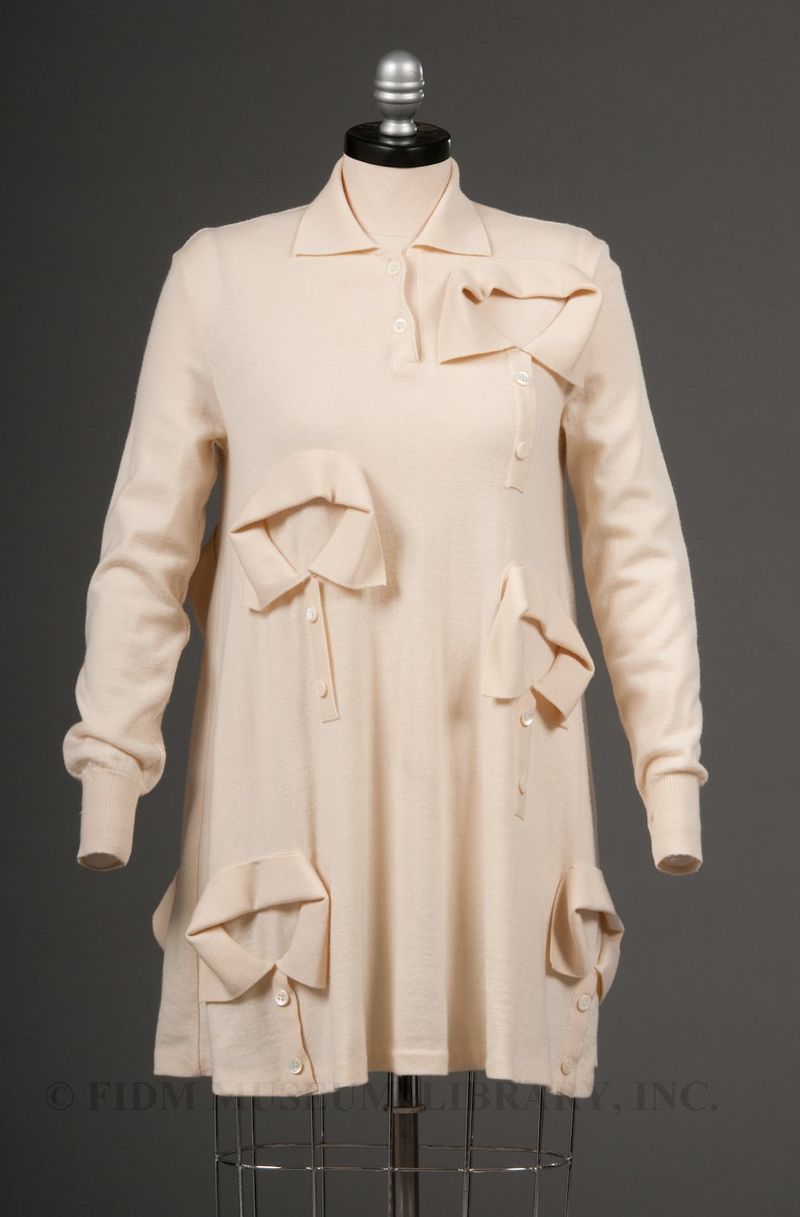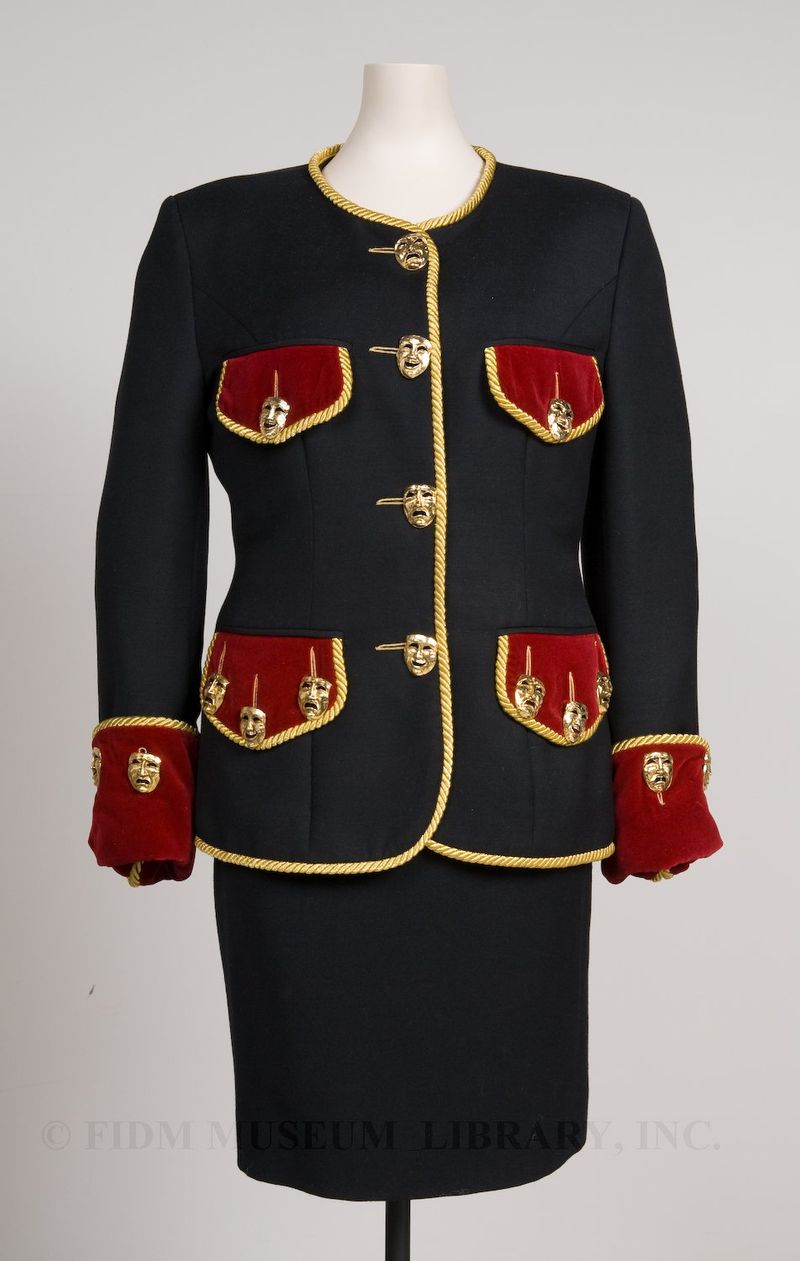By the time Franco Moschino (1950-1994) introduced his “Cheap and Chic” line in 1988, he had already earned a reputation as the irreverent “court jester” of the fashion world. From the time he debuted his first “Couture!” collection in 1983, Moschino treated fashion as an absurdist playground. Models were sent down the runway with candy-box tops instead of hats, wearing dresses patterned with faux tire tracks or dressed in giant Moschino shopping bags instead of garments. Tailored suits featured quirky details such as a collar made of teddy bears or pockets resembling miniature purses. “Stop the Fashion System” was a favorite catch-phrase, used in Moschino ad campaigns and as a logo on garments. Moschino considered being a fashion designer “a superficial, stupid job,” stating that he was more interested in the “social-psychological aspect” of fashion.1
 Cheap and Chic sweater
Cheap and Chic sweater
Franco Moschino
1992-1994
FIDM Museum Purchase
2005.5.26
Despite Moschino’s stated disdain for the exalted role of the fashion designer, this Cheap and Chic sweater demonstrates his deep knowledge of both artistic and fashion traditions. The additional collars mark it as a tribute Surrealism, an artistic movement originating in 1930s Paris which urged a broader perspective on reality. Expressed in both literary and visual terms, Surrealism attempted to use aesthetics as a means to liberate consciousness. Its visual qualities were based on the surprising juxtaposition of unexpected elements, such as those seen in the paintings of Salvador Dali. In the 1930s, fashion and Surrealism were linked most notably in the designs of Elsa Schiaparelli. Coming about 50 years after the heyday of Surrealism, Moschino’s sweater is a tribute to both the history of Surrealism and the talents of Schiaparelli.
In addition to their underlying intellectual references, Moschino’s designs should also be understood in terms of a playful silliness. He was aware that his more extreme designs sometimes bordered on the vulgar or tacky. In 1988, Moschino declared, “We’ve been doing vulgar, unfeminine, tasteless clothes. People say we’re not very refined. But just go out on the street and see how un-chic is humankind.”2 In the same interview, he called his own work “a little tacky.”
The Moschino Couture suit seen below is a more subtle example of Moschino’s quirky aesthetic. Perfectly appropriate and wearable, it is only on close examination that the somewhat outlandish comedy/tragedy buttons become apparent.

Comedy/tragedy suit
Moschino Couture
1992-93
FIDM Museum Purchase
2005.5.40A-D
Based on what you’ve seen of Moschino’s aesthetic, what do you think? Tacky, vulgar, or just playful?
1 Gross, Michael. “Moschino: Milan’s Impertinent Designer” New York Times 9 Oct. 1986: C8.
2 Hochswender, Wendy. “Patterns” New York Times 6 Dec. 1988: B16.



(e) None of the above.
It seems more like attention grabbing marketing to me. Schiaparelli and Dali were both consummately capable artists in the traditions of their craft, as well as exceedingly creative and innovative in extending (or distorting, if you prefer) their art.
I don’t see that talent in Moschino, at least as presented here. The cut of the garments is bland, and the attention grabbing additions are poorly implemented, at best.
Hmmm…I’ve been thinking about your comment, Catx. I think that part of what you’re saying is that he’s covering old ground and not pushing the boundaries of what Surrealist art could/can be. The Surrealist “moment” occured during the 1930s and was in response to a very particular cultural situation. Does Moschino’s work, outside of this specific context, simply become gimmicky?
Though I think the artists in the surrealist movement had a bigger impact because of the time they were living in, I can still appreciate a designer like Moschino who both keeps a sense of humour about his designs while maintaining a practical aesthetic (not that I am dismissing the un-practical; there is a time for the ridiculous as well, but I think it takes a certain amount of skill to pull off a type of refined kitsch).
Hi,
I have a cheap and chic vest that’s black with red trim ,wood Russian doll buttons and 100% wool and no size tag. Would you be able to tell me anything about it.
Thanks
Hi, we’re sorry we don’t know the piece you describe…Moschino produced so many things!
I do like the first one .. so daily /mundane as an item .. or ‘staple piece’ and then the addition of the extra buttons and neck holes ? The name ‘Cheap and Chic sweater’ reminds me of a trendy staple piece brand /‘Cheap and Chic’ sounds like a moderately successful hight street shop of the 2010s (even though the piece is dated 1992-1994); the whole design and name seems like a joke and a trend prediction into what was to follow , the ‘ludicrousy’ of the following decade’s high street and business man’s obsession, sexy basic staple pieces (think American Apparel, and then also HM group e.g Zara’s basic range)
As a design and as a concept (both within its era and now 2022 considering recent fashion history , It’s genius , even if somewhat irritating !